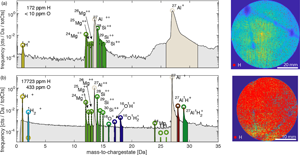Article contents
An Atom Probe with Ultra-Low Hydrogen Background
Published online by Cambridge University Press: 20 December 2021
Abstract

Atom probe tomography (APT) is a single-ion sensitive time-of-flight mass spectrometry method with near-atomic spatial resolution. In principle, it can be used to detect any chemical element, but so far hydrogen in the form of protium (1H) had to be largely excluded. This is owing to the residual H emitted from the stainless-steel chambers and in-vacuum parts commonly used in atom probe instrumentation. This residual H is then picked up in the APT experiment. In this paper, we show that by replacing the stainless-steel chamber and in-vacuum parts with titanium parts, this residual H can largely be removed, thus enabling the direct imaging of H using APT. We show that besides the drastic reduction of H, also other contaminants such as O, OH, and H2O are reduced by employing this instrument. In the current set-up, the instrument is equipped with high-voltage pulsing limiting the application to conductive materials.
- Type
- Detection of Hydrogen
- Information
- Copyright
- Copyright © The Author(s), 2021. Published by Cambridge University Press on behalf of the Microscopy Society of America
References
- 9
- Cited by





